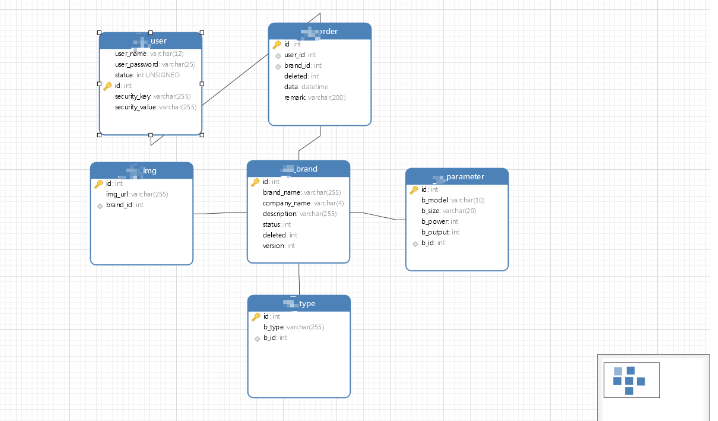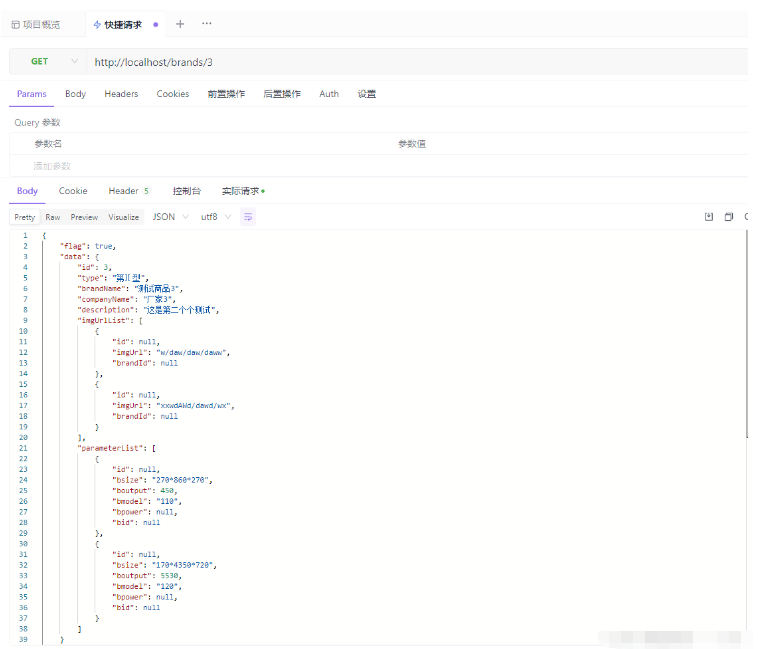 Java
Java
 javaTutorial
javaTutorial
 How to implement Springboot+Mybatis-plus without using SQL statements to add multiple tables
How to implement Springboot+Mybatis-plus without using SQL statements to add multiple tables
How to implement Springboot+Mybatis-plus without using SQL statements to add multiple tables
Do not use SQL statements to add multiple tables in Springboot Mybatis-plus
The preparation work for the problems I encountered is broken down by simulating thinking in the test environment: Create a BrandDTO object simulation with parameters Passing parameters in the background
Problems I encountered
We all know that it is extremely difficult to perform multi-table operations in Mybatis-plus. If you do not use Mybatis-plus- For tools like join, you can only configure the corresponding Mapper. Flexibility allows us to more flexibly modify the functions required by Party A.
But if I am going to do a very ordinary small project, which does not require any flexible changes, and I do not want to write SQL statements, I want to use Mybatis directly -plus function to add multi-table (one master and multiple copies) data, then what should I do?
Looking at the database, we can know that we have a product table, but productfor Product image, Product parameter and Product type are all one-to-many or many-to-one relationships, but I want our front-end to directly submit a form You can complete the addition of data in multiple tables. Multi-table operations are inevitable

Preparation work
Because I have used mybatis before this operation -plus-join multi-table query operation, so I have generated a DTO entity class
@Data
public class BrandDTO {
private Integer id;
//类型表
private String type;
//商品表
private String brandName;
private String companyName;
private String description;
//图片链接表
private List<Img> imgUrlList;
//参数表
private List<Parameter> parameterList;
}In this class you will wonder: Why don’t I directly encapsulate a Brand entity object?
Because I have used this class to perform join table queries before, and put the parameters of each entity class separately (there is no duplicate name hhhh), and this class needs to be displayed, so I added the attributes of the Brand class as they are, and The tpye corresponding to Brand should be many (type) to one (Brand), so I only encapsulated one here, but since Brand has a one-to-many relationship with Img and Parameter, I encapsulated them into a list< object >, In this way we got something similar to an intermediate class
Simulated in the test environment
We might as well think about it, with such a class, we only need to separate the parameters To add to each table, we need to imagine that we get a BrandDTO object encapsulating data, and then disassemble it and use the methods of the respective mapper interfaces to insert the table behavior
(First the interface must inherit the corresponding BaseMapper<> ;, you can perform quick operations. Of course, if you have a corresponding adding method in the interface, you can also do it, but since we use mybatis-plus, why do we have to go back and write the adding method ourselves?)
So, after After several repeated experiments, I got the following test method:
@Test
public void addBrand(){
Brand brand = new Brand();
Type type = new Type();
Img img = new Img();
Parameter parameter = new Parameter();
BrandDTO brandDTO = new BrandDTO();
brandDTO.setBrandName("测试商品3");
brandDTO.setCompanyName("厂家3");
brandDTO.setDescription("这是第二个个测试");
brandDTO.setType("第Ⅱ型");
List<Img> imgs =new ArrayList<>();
imgs.add(new Img("w/daw/daw/daww"));
imgs.add(new Img("xxwdAWd/dawd/wx"));
brandDTO.setImgUrlList(imgs);
List<Parameter> parameters = new ArrayList<>();
parameters.add(new Parameter("110","270*860*270",30,450));
parameters.add(new Parameter("120","170*4350*720",990,5530));
brandDTO.setParameterList(parameters);
List<Img> imgUrlList = brandDTO.getImgUrlList();
List<Parameter> parameterList = brandDTO.getParameterList();
brand.setBrandName(brandDTO.getBrandName());
brand.setCompanyName(brandDTO.getCompanyName());
brand.setDescription(brandDTO.getDescription());
brandMapper.insert(brand);
Integer id = brand.getId();
type.setBType(brandDTO.getType());
type.setBId(id);
typeMapper.insert(type);
for (Parameter parameterl : parameterList) {
parameter.setBModel(parameterl.getBModel());
parameter.setBOutput(parameterl.getBOutput());
parameter.setBSize(parameterl.getBSize());
parameter.setBId(id);
parameterMapper.insert(parameter);
}
for (Img imgl : imgUrlList) {
img.setImgUrl(imgl.getImgUrl());
img.setBrandId(id);
imgMapper.insert(img);
}
System.out.println(id);
}Thinking breakdown:
Next, I will decompose and express each part of the method body
Create A BrandDTO object with parameters
First we simulated a BrandDTO object encapsulating various parameters:
Type type = new Type();
Img img = new Img();
Parameter parameter = new Parameter();
BrandDTO brandDTO = new BrandDTO();
brandDTO.setBrandName("测试商品3");
brandDTO.setCompanyName("厂家3");
brandDTO.setDescription("这是第二个个测试");
brandDTO.setType("第Ⅱ型");
List<Img> imgs =new ArrayList<>();
//此操作能成功是因为我在对应的对象中生成了除了id属性和外键属性的有参构造
imgs.add(new Img("w/daw/daw/daww"));
imgs.add(new Img("xxwdAWd/dawd/wx"));
brandDTO.setImgUrlList(imgs);
List<Parameter> parameters = new ArrayList<>();
//此操作能成功是因为我在对应的对象中生成了除了id属性和外键属性的有参构造
parameters.add(new Parameter("110","270*860*270",30,450));
parameters.add(new Parameter("120","170*4350*720",990,5530));
brandDTO.setParameterList(parameters);This part is mainly the encapsulation of parameters, which is the work of the front end. Let us do the background work The server receives a BrandDTO object with parameters
Simulates passing parameters to the background
Takes out the corresponding parameters in each table
//取出ImgUrlList和ParameterList()
List<Img> imgUrlList = brandDTO.getImgUrlList();
List<Parameter> parameterList = brandDTO.getParameterList();
//单独封装brand对象
brand.setBrandName(brandDTO.getBrandName());
brand.setCompanyName(brandDTO.getCompanyName());
brand.setDescription(brandDTO.getDescription());
//调用对应Mapper接口的insert方法(或者你自己写的添加方法)
brandMapper.insert(brand);
//使用主键返回(要确保mybatis中设置了主键自增并且在各个实体类中声明了主键属性)
Integer id = brand.getId();After the above operations, we report to Brand A row of information is added to the table, and the primary key is returned.
So our other tables know the ID of the corresponding product, and can use this ID to define the foreign key ID in the table:
(Please note that in this test class, I injected the Mapper interface of each entity class that I need to use, so I can call the insert method)
//向Type表中添加数据并指定外键(BrandID)的id
type.setBType(brandDTO.getType());
type.setBId(id);
typeMapper.insert(type);
//向Paramater表中添加数据并指定外键(BrandID)的id
for (Parameter parameterl : parameterList) {
parameter.setBModel(parameterl.getBModel());
parameter.setBOutput(parameterl.getBOutput());
parameter.setBSize(parameterl.getBSize());
parameter.setBId(id);
parameterMapper.insert(parameter);
}
//向Img表中添加数据并指定外键(BrandID)的id
for (Img imgl : imgUrlList) {
img.setImgUrl(imgl.getImgUrl());
img.setBrandId(id);
imgMapper.insert(img);
}Use a loop Add, we can add the data in the object to each table one by one. Next, we need to use the console to get the primary key id corresponding to the product we added:
System.out.println(id);
After that we run, what I got here The data is 3, and then we call the method of querying products by ID:
I am using Apifox here:

It can be seen that our information has been inserted into the table The return value part is null because the multi-table query I wrote has some small bugs, but there is still data in the database. It can be seen that this test is successful. Next, just CV the code to the corresponding service. The controller layer can simulate passing in a Json object to check whether it is feasible!
The above is the detailed content of How to implement Springboot+Mybatis-plus without using SQL statements to add multiple tables. For more information, please follow other related articles on the PHP Chinese website!

Hot AI Tools

Undresser.AI Undress
AI-powered app for creating realistic nude photos

AI Clothes Remover
Online AI tool for removing clothes from photos.

Undress AI Tool
Undress images for free

Clothoff.io
AI clothes remover

AI Hentai Generator
Generate AI Hentai for free.

Hot Article

Hot Tools

Notepad++7.3.1
Easy-to-use and free code editor

SublimeText3 Chinese version
Chinese version, very easy to use

Zend Studio 13.0.1
Powerful PHP integrated development environment

Dreamweaver CS6
Visual web development tools

SublimeText3 Mac version
God-level code editing software (SublimeText3)

Hot Topics
 1377
1377
 52
52
 What is the difference between HQL and SQL in Hibernate framework?
Apr 17, 2024 pm 02:57 PM
What is the difference between HQL and SQL in Hibernate framework?
Apr 17, 2024 pm 02:57 PM
HQL and SQL are compared in the Hibernate framework: HQL (1. Object-oriented syntax, 2. Database-independent queries, 3. Type safety), while SQL directly operates the database (1. Database-independent standards, 2. Complex executable queries and data manipulation).
 Usage of division operation in Oracle SQL
Mar 10, 2024 pm 03:06 PM
Usage of division operation in Oracle SQL
Mar 10, 2024 pm 03:06 PM
"Usage of Division Operation in OracleSQL" In OracleSQL, division operation is one of the common mathematical operations. During data query and processing, division operations can help us calculate the ratio between fields or derive the logical relationship between specific values. This article will introduce the usage of division operation in OracleSQL and provide specific code examples. 1. Two ways of division operations in OracleSQL In OracleSQL, division operations can be performed in two different ways.
 Comparison and differences of SQL syntax between Oracle and DB2
Mar 11, 2024 pm 12:09 PM
Comparison and differences of SQL syntax between Oracle and DB2
Mar 11, 2024 pm 12:09 PM
Oracle and DB2 are two commonly used relational database management systems, each of which has its own unique SQL syntax and characteristics. This article will compare and differ between the SQL syntax of Oracle and DB2, and provide specific code examples. Database connection In Oracle, use the following statement to connect to the database: CONNECTusername/password@database. In DB2, the statement to connect to the database is as follows: CONNECTTOdataba
 Detailed explanation of the Set tag function in MyBatis dynamic SQL tags
Feb 26, 2024 pm 07:48 PM
Detailed explanation of the Set tag function in MyBatis dynamic SQL tags
Feb 26, 2024 pm 07:48 PM
Interpretation of MyBatis dynamic SQL tags: Detailed explanation of Set tag usage MyBatis is an excellent persistence layer framework. It provides a wealth of dynamic SQL tags and can flexibly construct database operation statements. Among them, the Set tag is used to generate the SET clause in the UPDATE statement, which is very commonly used in update operations. This article will explain in detail the usage of the Set tag in MyBatis and demonstrate its functionality through specific code examples. What is Set tag Set tag is used in MyBati
 What does the identity attribute in SQL mean?
Feb 19, 2024 am 11:24 AM
What does the identity attribute in SQL mean?
Feb 19, 2024 am 11:24 AM
What is Identity in SQL? Specific code examples are needed. In SQL, Identity is a special data type used to generate auto-incrementing numbers. It is often used to uniquely identify each row of data in a table. The Identity column is often used in conjunction with the primary key column to ensure that each record has a unique identifier. This article will detail how to use Identity and some practical code examples. The basic way to use Identity is to use Identit when creating a table.
 Comparison and difference analysis between SpringBoot and SpringMVC
Dec 29, 2023 am 11:02 AM
Comparison and difference analysis between SpringBoot and SpringMVC
Dec 29, 2023 am 11:02 AM
SpringBoot and SpringMVC are both commonly used frameworks in Java development, but there are some obvious differences between them. This article will explore the features and uses of these two frameworks and compare their differences. First, let's learn about SpringBoot. SpringBoot was developed by the Pivotal team to simplify the creation and deployment of applications based on the Spring framework. It provides a fast, lightweight way to build stand-alone, executable
 How to solve the 5120 error in SQL
Mar 06, 2024 pm 04:33 PM
How to solve the 5120 error in SQL
Mar 06, 2024 pm 04:33 PM
Solution: 1. Check whether the logged-in user has sufficient permissions to access or operate the database, and ensure that the user has the correct permissions; 2. Check whether the account of the SQL Server service has permission to access the specified file or folder, and ensure that the account Have sufficient permissions to read and write the file or folder; 3. Check whether the specified database file has been opened or locked by other processes, try to close or release the file, and rerun the query; 4. Try as administrator Run Management Studio as etc.
 How to use SQL statements for data aggregation and statistics in MySQL?
Dec 17, 2023 am 08:41 AM
How to use SQL statements for data aggregation and statistics in MySQL?
Dec 17, 2023 am 08:41 AM
How to use SQL statements for data aggregation and statistics in MySQL? Data aggregation and statistics are very important steps when performing data analysis and statistics. As a powerful relational database management system, MySQL provides a wealth of aggregation and statistical functions, which can easily perform data aggregation and statistical operations. This article will introduce the method of using SQL statements to perform data aggregation and statistics in MySQL, and provide specific code examples. 1. Use the COUNT function for counting. The COUNT function is the most commonly used



